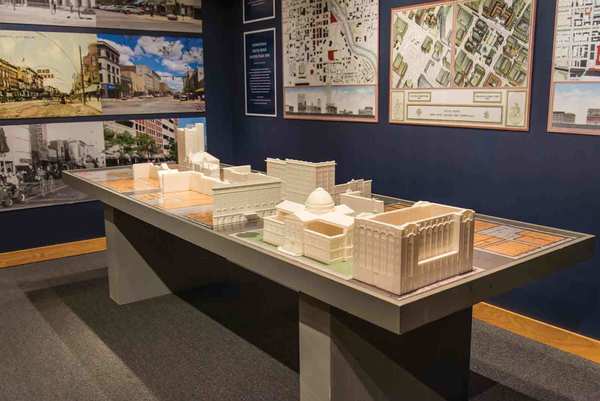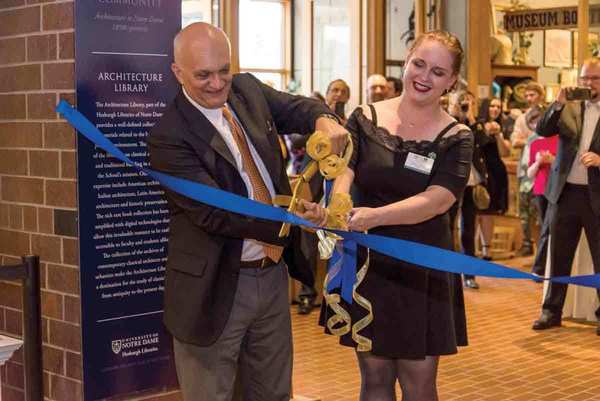The newest exhibit in the Ernestine M. Raclin Gallery of Notre Dame History at The History Museum, “Commitment, Continuity, and Community: Architecture at Notre Dame, 1898 to the present,” tells the story of the School of Architecture’s 120-year history and its commitment to the study of classical architecture and the design of beautiful, sustainable environments.
 The exhibition includes artifacts, publications and 3-D models.
The exhibition includes artifacts, publications and 3-D models.
“I was delighted by the wide range of artifacts and publications available from the Notre Dame archives and the Architecture Library that were used to tell the story,” said The History Museum Registrar Kristi Dunn.
A dome-shaped wood model painted with the mural images portrayed inside the Main Building dome, scanned sketches of the figures Luigi Gregori (1819-1896) painted in the Basilica and a small can of gold leaf used to regild the Dome in 1933 are among the artifacts that represent cherished campus buildings.
Publications from the Architecture Library’s collection underscore the school’s presence in Rome and Cuba. A 1933 publication on Havana’s Capitol Building, “El Capitolio,” highlights the work of the school’s first graduate, Eugenio Rayneri Piedra. Built in 1929, the building housed the government until the Cuban Revolution in 1959 and today is home to the Cuban Academy of Sciences.
In recognition of the school’s 50 years of studies in Rome, the exhibit includes a 3-D map of a Rome cityscape showing the architecture of the ancient city, photos of architecture students studying in Rome and rare architectural treatises published in the 1500s by Andrea Palladio and Vitruvius Pollio, which are the oldest publications ever on display at the museum.
A book donated to the University by Frank Lloyd Wright, a ticket to his campus lecture and images of Wright’s DeRhodes House in South Bend bring to light the famous architect’s connection to the University and the community. Early American “pattern books” featuring home designs popular over 100 years ago are also on display along with photos of the only Sears “Honor Bilt” Magnolia home in South Bend.
“I’m very pleased with how this exhibit came together,” says Jennifer Parker, architecture librarian. “The exhibit highlights the Architecture Library’s support for the School of Architecture as its goal to be a partner in education on every level.”
The school’s commitment to architectural excellence in modern times is recognized in a display dedicated to the Richard H. Driehaus Prize, the prestigious annual award recognizing distinguished architects whose work reflects excellence in traditional and classical architecture and its implementation in contemporary society. A scale model of Walsh Family Hall, the School of Architecture’s new home (currently under construction), affirms the school’s durable presence in the future.
The exhibit also boasts fun, interactive features for viewers’ enjoyment. In collaboration with the Historic Preservation Commission of South Bend and St. Joseph County and the museum, the Architecture Library created “Building South Bend: Past, Present & Future” a multi-platform digital tool featuring a website, mobile application, 3-D printed model and interactive virtual-reality experience highlighting the history of South Bend’s architecture.
 Dean Michael Lykoudis opens the exhibition with Kristi J. Dunn, History Museum registrar.
Dean Michael Lykoudis opens the exhibition with Kristi J. Dunn, History Museum registrar.
A detailed Sanborn fire insurance map layered into a plan of downtown South Bend from the 1920s sits on a table with 3-D printed models of notable landmark buildings in South Bend. “Children are enthralled with the 3-D models of downtown buildings. They like to move the buildings around on the map table,” says the museum’s Deputy Executive Director Brandon Anderson.
The exhibit inspires, informs and surprises viewers with scale models, artifacts, publications, factoids and maps, bringing to life the School of Architecture’s legacy at Notre Dame and the communities it has touched, especially South Bend. “While it’s coming together, it’s hard to envision the finished product,” says Anderson. “Now that the exhibit is up, I think it’s one of the best exhibits we’ve ever put together in this gallery.”
The exhibition, “Commitment, Continuity, and Community: Architecture at Notre Dame, 1898 – Present” continues through Aug. 5, 2018, at The History Museum, 808 W. Washington St., South Bend. Visit the website at historymuseumsb.org for more information on hours, programs and tours.